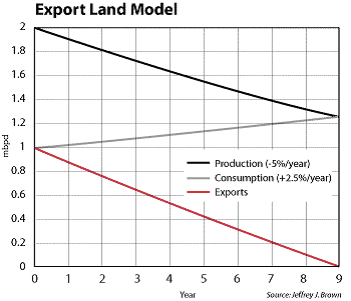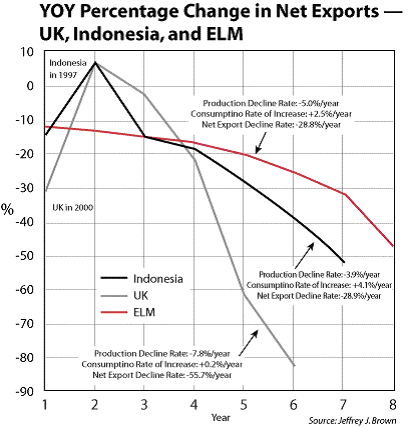Oil price: it's all about the supply
Lots of people still expect that market forces will always bring ample oil supplies to market, and that rising prices can largely be explained through speculation and geopolitics. The reality is very different.
People are amazed by numbers. Benchmarks and records can have huge psychological effects on the way people view a problem. So why are people so slow to react to this new milestone?
Oil has finally reached $100 per barrel, yet few people on the distant end of oil supply lines are aware of how fast the status quo can change. The status quo tells us to expect more oil when we want it. That market forces always bring ample oil supplies to market. That oil producers will always accept a fixed amount of paper money in exchange for concentrated liquid energy.
But the status quo view of the oil market has been wrong for years. Many still use speculation and geopolitics, rather than supply and demand, to explain rising prices. These pundits never question whether the exchange of paper money for black gold is sustainable. In the old days, when oil prices rose, big exporters like the Saudis recycled most of their oil money into the U.S. bond market, giving rise to the term "petrodollars." But those days are long gone. Middle East oil producers now pump lots of money into local economies and oil price subsidies. These policies have led to much higher oil consumption in OPEC countries and will keep lots of oil from ever reaching the export market.
MoneyWeek
Subscribe to MoneyWeek today and get your first six magazine issues absolutely FREE

Sign up to Money Morning
Don't miss the latest investment and personal finances news, market analysis, plus money-saving tips with our free twice-daily newsletter
Don't miss the latest investment and personal finances news, market analysis, plus money-saving tips with our free twice-daily newsletter
The oil trade has radically changed, and investors need to understand these changes. So it helps to look at a model of a hypothetical oil exporting country.
Jeffrey Brown's Export Land Model accomplishes this. It shows how dramatically exports can decline when two things occur at the same time: Domestic consumption increases while production declines. Brown, an independent petroleum geologist who writes for The Oil Drum, presented his Export Land Model at the ASPO-USA conference in October. When you really think about this model, the debate over how much oil is in the ground becomes trivial. Rather, we should think about how much oil could be available for export in the coming decade.
Brown's model is easy to understand. It makes sense. Several historical examples validate it. Yet this line of thinking is totally outside the mainstream. As Brown explains, his model represents:
"A hypothetical country with ultimate recoverable reserves of about 38 billion barrels The model showed the effect on net exports of a country that hit peak production and started declining at 5% per year. The exporting country consumes 50% of its production, and that consumption is increasing by 2.5% per year. The 5% decline rate is loosely based on the post-peak Texas decline rate of about 4% per year."

The red line in this chart shows that "export land" starts off exporting one million barrels per day. Because production, the black line, is declining at 5% per year and consumption, the gray line, is increasing at 2.5% per year, exports plunge to zero in less than a decade. Brown mentions two other important points about the model. First,
"Only about 1.7 billion barrels, or 10%, of remaining post-peak recoverable reserves would be exported.
"Second, the overall exponential net export decline rate, about 29% per year over the eight-year net export decline period, is much more rapid than the production decline rate of 5% per year."
The following chart shows how Brown's model compares with two recent case histories: Indonesia and the United Kingdom. Indonesia, depicted in black, reached peak production in the late 1990s and has almost become a net oil importer. The U.K., depicted in gray, peaked around the turn of the century and became a net oil importer in just a few short years. U.K. North Sea production declined rapidly because offshore fields tend to have very high decline rates:

The top five net oil exporters from 2000-2005 were Saudi Arabia, Russia, Norway, Iran and the United Arab Emirates. Oil consumption in these five countries grew 3.7% per year over this period. Since 2005, consumption growth has accelerated in a few of these countries, so net exports from the top five may decline at a much faster rate than the market expects. We may have seen only the early stages of oil price increases.
Geopolitical power will shift to oil exporters
How will the U.S., so reliant on imported oil, cope in an environment of tightening world oil exports? Most U.S. consumers have been sleepwalking on the march to $100 oil. Instead of understanding where oil comes from and altering consumption habits, the public seems more interested in taxing "greedy" oil companies. The longer this happens, the more painful the adjustment will be. Most of us don't realize that the U.S. no longer has a monopoly on the world's oil exportslet alone the implications.
Hugo Chavez just announced that Venezuela will export 500,000 barrels per day of crude to China in 2008, up from the current level of 350,000 barrels per day. He wants to increase shipments to one million barrels per day by 2012. Whether he achieves this goal or not, one thing is clear: Venezuela will soon be shipping lots more oil to China than it will to the U.S.
Mexican oil production is declining so fast that it will likely become a net oil importer within a few years. Kazakhstan is unilaterally renegotiating contracts with foreign oil companies to increase the government's share of growing oil revenues. African countries like Nigeria may do the same with companies like Exxon Mobil.
For years, China has aggressively pursued contracts to secure reliable oil supplies, especially in regions like Africa. As it currently stands, the U.S. has no energy security plan other than to remain friendly with Saudi Arabia and hope that country meets its production goals. But even if OPEC can keep production high enough to meet insatiable demand, it's unlikely that it will ship oil in the same quantities to the same customers.
Another thing to keep in mind, which we saw unfold in early November, is Ben Bernanke's dilemma. With oil and gold at record highs, can he really afford to slash short-term interest rates to help save housing? Though he likes to bluff, he can't afford to push rates down to 1%, as Greenspan did in the last easing cycle. If he did, another round of dollar weakness would drive international investors to gold and tangible assets even faster. It would also make oil less expensive in stronger foreign currencies, which would draw more oil supply to foreign markets.
Under a worst-case scenario, within a few years, much of the world's tradable crude oil could be withdrawn from futures markets and locked up under long-term supply agreements with "favored" customers. And current trends point to the U.S. losing its favored customer status, even among longtime reliable suppliers from the Middle East.
Middle Eastern wealth looking inward
I maintain regular contact with a private equity fund manager. He just returned from a trip to the Middle East to gauge the local interest in alternative investments. He wrote:
"The gulf is earning $1 trillion every two years, assuming $80 oil. We met with one of the ruling families in the region, and it anticipates no fall in oil prices anytime soon. One question I asked on the trip was how long we should expect the U.S. dollar/Middle East currency pegs to last. I expected a lot of strange looks and party line answers about how they'd be shooting themselves in the foot, since the U.S. is their largest customer, but almost uniformly, people thought a major move away from the dollar is 18-36 months away. But rather than a completely free-floating currency, they believe the basket' approach of Kuwait is likely to be the outcome."
Since the dollar is about half of the Kuwaiti currency basket, the impact has been somewhat muted. My contact also noted an unmistakable trend common to all Middle Eastern sovereign wealth funds they are moving away from U.S. Treasuries with two specific goals in mind. First, they are looking for higher returns in alternative asset classes like hedge and private equity funds. And second, they want to shift portfolio exposure from the West to their home markets particularly in local infrastructure. This includes roads, utilities, schools and hospitals. Growing Middle Eastern wealth is leading to higher living standards, which leads naturally to higher oil consumption.
This isn't the behavior of investors seeking to maintain their end of the status quo "oil for U.S. dollar" trade. So the writing is on the wall for the petrodollar trade.
What does this mean for the U.S. and other oil importers? It means the global drilling rig fleet will grow in importance. The rig fleet must become more productive, because target oil and gas reservoirs are becoming smaller and more scattered. The recent spike in drilling activity has strained the industry.
If spikes like these continue, the equipment will become worn out quickly and oil prices will then continue to rise.
By Dan Amoss for Whiskey and Gunpowder
Watch a video interview with Merryn Somerset Webb on the impact of oil price rises.
Get the latest financial news, insights and expert analysis from our award-winning MoneyWeek team, to help you understand what really matters when it comes to your finances.
MoneyWeek is written by a team of experienced and award-winning journalists, plus expert columnists. As well as daily digital news and features, MoneyWeek also publishes a weekly magazine, covering investing and personal finance. From share tips, pensions, gold to practical investment tips - we provide a round-up to help you make money and keep it.



